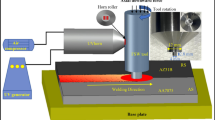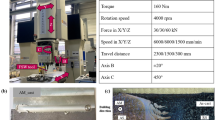Abstract
In this paper, it has been presented that with macroscopic study of nugget and using “effective distance” (ED) index, the reason of different strength of joints, which are welded with different parameters and from different materials, can be explained. Welds that have longer ED carry more static lodes compared to others. ED is the linear distance of Hook tip, i.e., the separation point of two overlapped sheets in partially bounded region which is crack initiation point, and keyhole. It has presented that Hook tip geometry also is an important factor that affects joint strength. The zig-zag Hook tip type is present at high strength welds while straight Hook tip can be seen for low strength joints. Lower tool rotational speed and higher tool plunge rate result longer ED and higher shear strength. ED is shorter for joints that are welded from dissimilar alloys compared to similar ones and joint strength differs similarly. The highest shear strength was 3050 N which was obtained with specimen that was welded from similar 6063-T3 aluminum sheets with tool rotational speed of 800 rpm and tool plunge rate of 80 mm/min. For this specimen, effective distance was 2025 μm.









Similar content being viewed by others
References
Tran VX, Pan J (2010) Effects of weld geometry and sheet thickness on stress intensity factor solutions for spot and spot friction welds in lap-shear specimens of similar and dissimilar materials. Eng Fract Mech 77(9):1417–1438
Yin YH, Ikuta A, North TH (2010) Microstructural features and mechanical properties of AM60 and AZ31 friction stir spot welds. Mater Des 31(10):4764–4776
Tran VX, Pan J, Pan T (2009) Effects of processing time on strengths and failure modes of dissimilar spot friction welds between aluminum 5754-O and 7075-T6 sheets. J Mater Process Technol 209(8):3724–3739
Merzoug M et al (2010) Parametric studies of the process of friction spot stir welding of aluminium 6060-T5 alloys. Mater Des 31(6):3023–3028
Uematsu Y et al (2008) Effect of re-filling probe hole on tensile failure and fatigue behaviour of friction stir spot welded joints in Al–Mg–Si alloy. Int J Fatigue 30(10–11):1956–1966
Tozaki Y, Uematsu Y, Tokaji K (2010) A newly developed tool without probe for friction stir spot welding and its performance. J Mater Process Technol 210(6–7):844–851
Zhang Z et al (2011) Effect of welding parameters on microstructure and mechanical properties of friction stir spot welded 5052 aluminum alloy. Mater Des 32(8–9):4461–4470
Çam G, Mistikoglu S (2014) Recent developments in friction stir welding of Al-alloys. J Mater Eng Perform 23(6):1936–1953
Thoppul SD, Gibson RF (2009) Mechanical characterization of spot friction stir welded joints in aluminum alloys by combined experimental/numerical approaches: part II: macromechanical studies. Mater Charact 60(11):1352–1360
Tozaki Y, Uematsu Y, Tokaji K (2007) Effect of tool geometry on microstructure and static strength in friction stir spot welded aluminium alloys. Int J Mach Tools Manuf 47(15):2230–2236
Mishra RS, Ma ZY (2005) Friction stir welding and processing. Mater Sci Eng R Rep 50(1–2):1–78
Tier MD et al (2013) The influence of refill FSSW parameters on the microstructure and shear strength of 5042 aluminium welds. J Mater Process Technol 213(6):997–1005
Yang J et al (2013) Effects of rotation rates on microstructure, mechanical properties, and fracture behavior of friction stir-welded (FSW) AZ31 magnesium alloy. Metall Mater Trans A 44(1):517–530
Lin Y-C, Liu J-J, Chen J-N (2013) Material flow tracking for various tool geometries during the friction stir spot welding process. J Mater Eng Perform 22(12):3674–3683
Gao Z et al (2013) FE modelling of microstructure evolution during friction stir spot welding in AA6082-T6. Weld World 57(6):895–902
Mahmoud TS, Khalifa TA (2014) Microstructural and mechanical characteristics of aluminum alloy AA5754 friction stir spot welds. J Mater Eng Perform 23(3):898–905
Babu S et al (2013) Microstructures and mechanical properties of friction stir spot welded aluminum alloy AA2014. J Mater Eng Perform 22(1):71–84
Rostamiyan Y et al. Experimental studies on ultrasonically assisted friction stir spot welding of AA6061. Arch Civ Mech Eng, (0)
Zhang Z-K et al (2014) Friction stir keyholeless spot welding of AZ31 Mg alloy-mild steel. Trans Nonferrous Metals Soc China 24(6):1709–1716
Tutar M et al (2014) The optimisation of process parameters for friction stir spot-welded AA3003-H12 aluminium alloy using a Taguchi orthogonal array. Mater Des 63:789–797
Bozkurt Y, Bilici MK (2013) Application of Taguchi approach to optimize of FSSW parameters on joint properties of dissimilar AA2024-T3 and AA5754-H22 aluminum alloys. Mater Des 51:513–521
Wang DA, Lee SC (2007) Microstructures and failure mechanisms of friction stir spot welds of aluminum 6061-T6 sheets. J Mater Process Technol 186(1–3):291–297
Lin PC, Pan J, Pan T (2008) Failure modes and fatigue life estimations of spot friction welds in lap-shear specimens of aluminum 6111-T4 sheets. Part 1: welds made by a concave tool. Int J Fatigue 30(1):74–89
Lin PC, Pan J, Pan T (2008) Failure modes and fatigue life estimations of spot friction welds in lap-shear specimens of aluminum 6111-T4 sheets. Part 2: welds made by a flat tool. Int J Fatigue 30(1):90–105
Klobčar D et al. Parametric study of FSSW of aluminium alloy 5754 using a pinless tool. Weld World, 2014
Pathak N et al (2012) Microstructure and mechanical performance of friction stir spot-welded aluminum-5754 sheets. J Mater Eng Perform 22(1):131–144
Badarinarayan H et al (2009) Effect of tool geometry on hook formation and static strength of friction stir spot welded aluminum 5754-O sheets. Int J Mach Tools Manuf 49(11):814–823
Buffa G, Fratini L, Piacentini M (2008) On the influence of tool path in friction stir spot welding of aluminum alloys. J Mater Process Technol 208(1–3):309–317
Bozzi S et al (2010) Intermetallic compounds in Al 6016/IF-steel friction stir spot welds. Mater Sci Eng A 527(16–17):4505–4509
Shiraly M et al (2013) Effect of tool rotation rate on microstructure and mechanical behavior of friction stir spot-welded Al/Cu composite. J Mater Eng Perform 23(2):413–420
Song X et al (2014) Effect of plunge speeds on hook geometries and mechanical properties in friction stir spot welding of A6061-T6 sheets. Int J Adv Manuf Technol 71(9–12):2003–2010
Nandan R, DebRoy T, Bhadeshia HKDH (2008) Recent advances in friction-stir welding—process, weldment structure and properties. Prog Mater Sci 53(6):980–1023
Author information
Authors and Affiliations
Corresponding author
Additional information
Recommended for publication by Commission IX - Behaviour of Metals Subjected to Welding
Rights and permissions
About this article
Cite this article
Sajed, M., Bisadi, H. Experimental failure study of friction stir spot welded similar and dissimilar aluminum alloys. Weld World 60, 33–40 (2016). https://doi.org/10.1007/s40194-015-0268-6
Received:
Accepted:
Published:
Issue Date:
DOI: https://doi.org/10.1007/s40194-015-0268-6




